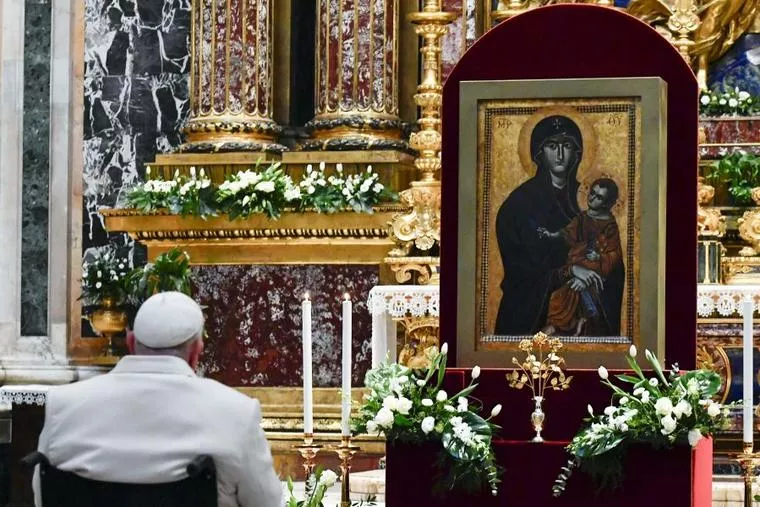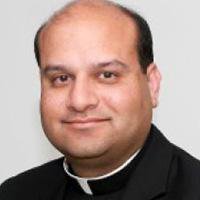
COMMENTARY: Of all the great basilicas of Rome, the one dedicated to the Blessed Mother was his favorite.
SIGN UP FOR OUR NEWSLETTER HERE
On the night of his election on March 13, 2013, Pope Francis told the assembled faithful from the balcony of St. Peter’s Basilica that “tomorrow I wish to go and pray to the Madonna.”
And so he did, visiting the Basilica of St. Mary Major the next day. It was his first trip. It will also be his final trip, as his mortal remains will be taken there for burial. In between, he visited more than 100 times.
There are four major “papal basilicas” in Rome: St. Peter’s in the Vatican, St. Mary Major, St. John Lateran and St. Paul Outside the Walls. St. Mary Major was the Holy Father’s favorite.
St. Mary Major: An Ancient Icon
That first full day of his pontificate, Pope Francis traveled across town to St. Mary Major to pray before the venerated image of Mary, Salus Populi Romani, “Protectress of the Roman People.” The icon, by pious tradition painted by St. Luke, first came to Rome from the East in the fifth century, when Mary was declared the Theotokos — Mother of God — at the Council of Ephesus in 431.
Pope St. Gregory the Great had the image carried in procession through Rome during an outbreak of the plague in 593. During the COVID-19 pandemic, on March 15, 2020, Pope Francis visited St. Mary Major as he walked alone in the empty Roman streets to pray for his city. Twelve days later, during his solitary Eucharistic adoration to pray for an end to the pandemic, the Salus Populi Romani was brought to St. Peter’s for the occasion.
That ancient icon, much beloved by the local people, gained new prominence toward the end of World War II, when Pope Pius XII asked all Romans to beseech the Madonna to protect the city from devastation as Allied troops moved closer. Fearing that a battle between Allied and German forces would devastate the city, the faithful gathered in prayer on June 4, 1944. By that evening, the last German troops had withdrawn and the Allies secured the city peacefully. Mary, under the title of Salus Populi Romani, was given thanks.
Last year, for the 80th anniversary of the liberation of Rome, a local feast day was observed in the Diocese of Rome for the Blessed Mother under the title, Salus Populi Romani — with June 4 fixed as the date.
Pope Pius XII, himself a Roman, had a particular devotion to that “local” Marian image. Ordained a priest on Easter Sunday 1899, Father Eugenio Pacelli offered his first Mass the next day, April 3, 1899, in the chapel of the Salus Populi Romani icon at St. Mary Major — the very same chapel that Pope Francis visited the day after his election.
Cardinal Jorge Bergoglio had a devotion to that icon before his election, visiting it when he came to Rome. That pious practice is not rare. For example, Cardinal Timothy Dolan of New York also visits St. Mary Major upon arrival in Rome, often going straight there from the airport.
Pope Francis decided to visit the icon before every foreign trip. And whenever he returned to Rome, his motorcade often went to St. Mary Major first, before returning to the Vatican.
The Holy Father ordered a restoration of the icon and, upon the completion of the work in January 2018, came to St. Mary Major to offer a Mass of thanksgiving and rededication.
In 2023, Pope Francis announced that he would be buried at St. Mary Major; his tomb has been prepared near the Salus Populi Romani icon. While most popes are buried at St. Peter’s in the Vatican, Pope Francis will be the eighth to be buried at St. Mary Major.
The last pope to be buried outside the Vatican was Pope Leo XIII in 1903, who chose to have his tomb at the Archbasilica of St. John Lateran. Leo’s predecessor, Blessed Pius IX, chose to be buried at St. Lawrence Outside the Walls.
The Lateran Archbasilica — Cathedral of Rome
In the history of the papacy, the Lateran grounds and complex were originally more important than the Vatican. The Lateran was the residence of the popes for a thousand years — longer than St. Peter’s. Five ecumenical councils have been held at the Lateran; two have been held at the Vatican.
The Lateran archbasilica (the only “archbasilica” in the world) remains the cathedral of Rome, the seat of the bishop of Rome. It became the cathedral, seat of the bishop of Rome, in the fourth century, and it remained the cathedral even after the popes transferred their residence to the Vatican.
Leo XIII (1878-1903) came to the papacy while the question of the Papal States was still unresolved. Consequently, he never left the Vatican during his long 25-year pontificate. Knowing that a bishop belongs in his cathedral, he was determined to get there in death if he could not do so in life. Thus, he directed that his tomb be at St. John Lateran.
Over time, the Lateran became associated with the Holy Father as bishop of Rome and the Vatican with the pope as universal pastor of the Church, or supreme pontiff. However, given that the Holy Father is the universal pastor because he is bishop of Rome, St. John Lateran holds precedence.
Pope Francis chose to emphasize the role of bishop of Rome from the beginning, giving that office prominence since his balcony appearance the night of his election. Consequently, as with St. Mary Major, Pope Francis raised the prominence of St. John Lateran in an important way. Beginning around 2019, he began signing official documents as “given at the Lateran.” All papal documents are signed with a place, a date and the year of the pontificate. The common practice beforehand was to sign documents “at the Vatican.”
The basilicas of St. John Lateran and St. Mary Major are only a mile apart. St. John Paul II revived the custom of celebrating the Mass for Corpus Christi at St. John Lateran, followed by the Corpus Christi procession to St. Mary Major, where the final benediction would take place. Pope Francis held the Corpus Christi procession in different places over the years, but his last procession in 2024 followed that route from his cathedral (St. John Lateran) to his favorite church (St. Mary Major).
St. Peter’s — Masses Limited
While Pope Francis gave prominence to St. Mary Major and St. John Lateran, at St. Peter’s, his decision to forbid morning Masses at the many side altars of St. Peter’s was among his most regrettable. For many years, dozens of priests — locals who worked in the Roman Curia as well as pilgrim priests from around the world — would come to St. Peter’s early in the morning to offer Masses at the various altars, including those over the tombs of St. Leo the Great, St. Gregory the Great, St. Pius X, St. John XXIII and St. John Paul II.
Pilgrims would wait outside the sacristy and ask to join a priest who might be offering Mass in their language. For generations of priests and pilgrims, those morning Masses in St. Peter’s were spiritual highlights of a lifetime.
In 2021, Pope Francis abruptly ended the practice. It was an offense against the spiritual grandeur of Catholicism’s most famous church and cruel to pilgrims. Reversing that decision should be the first item for the new pope, restoring St. Peter’s as primarily a place of worship rather than a religious museum.
St. Mary Major and St. Ignatius of Loyola
The first Jesuit pope’s love for St. Mary Major links him to the first Jesuit, St. Ignatius of Loyola. Ignatius was ordained in 1537 and desired to offer his first Mass in the Holy Land. That proved impossible, so, after 18 months, Ignatius gave up waiting and decided to offer his first Mass in St. Mary Major, where the relics of the Bethlehem crib are preserved. If he could not go to Bethlehem, he would visit the relics of Bethlehem brought to Rome. To emphasize that connection, he chose Christmas 1538 for that first Mass in St. Mary Major.
Now the only son of St. Ignatius to become pope will await eternity at St. Mary Major.
This article was originally published on National Catholic Register.
Live Updates following the Pope's Passing

Father Raymond J. de Souza is the founding editor of Convivium magazine.







